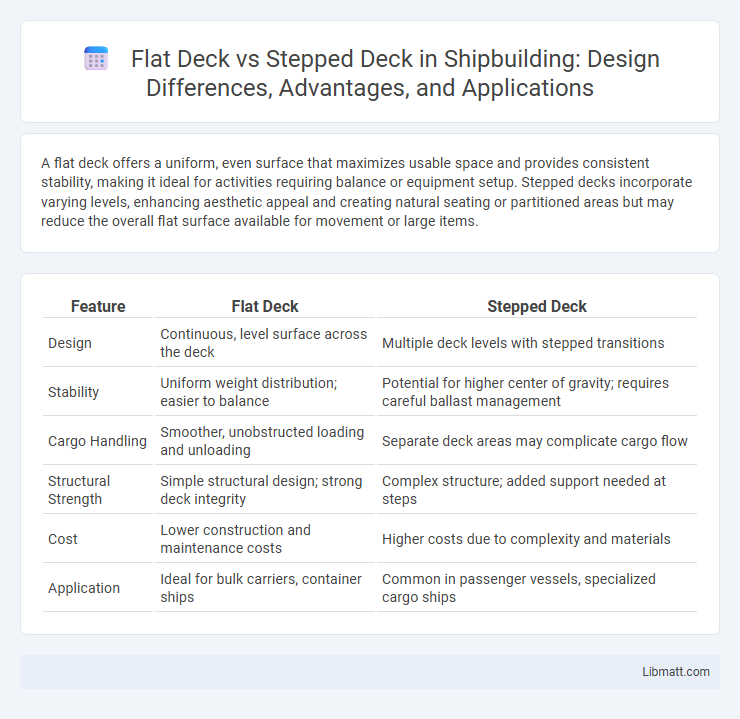A flat deck offers a uniform, even surface that maximizes usable space and provides consistent stability, making it ideal for activities requiring balance or equipment setup. Stepped decks incorporate varying levels, enhancing aesthetic appeal and creating natural seating or partitioned areas but may reduce the overall flat surface available for movement or large items.
Table of Comparison
| Feature | Flat Deck | Stepped Deck |
|---|---|---|
| Design | Continuous, level surface across the deck | Multiple deck levels with stepped transitions |
| Stability | Uniform weight distribution; easier to balance | Potential for higher center of gravity; requires careful ballast management |
| Cargo Handling | Smoother, unobstructed loading and unloading | Separate deck areas may complicate cargo flow |
| Structural Strength | Simple structural design; strong deck integrity | Complex structure; added support needed at steps |
| Cost | Lower construction and maintenance costs | Higher costs due to complexity and materials |
| Application | Ideal for bulk carriers, container ships | Common in passenger vessels, specialized cargo ships |
Introduction to Flat Deck vs Stepped Deck
Flat decks offer a continuous, level surface suitable for easy movement and optimal space utilization, ideal for activities requiring uniform footing. Stepped decks incorporate varying heights with distinct platforms, enhancing visual interest and defining separate functional areas within outdoor spaces. Your choice between flat deck vs stepped deck depends on the desired aesthetic, usability, and landscape integration.
Defining Flat Deck and Stepped Deck Designs
Flat deck designs feature a continuous, even surface that maximizes usable space and provides easy movement across the entire area. Stepped deck designs incorporate multiple levels or platforms, creating distinct zones that can enhance visual interest and functionality for activities such as seating or landscaping. Your choice between flat deck and stepped deck depends on how you want to balance open space with varied elevation for aesthetic and practical purposes.
Key Structural Differences
Flat decks feature a continuous, level surface providing uniform structural support, ideal for maximizing usable space and load distribution. Stepped decks incorporate multiple levels or tiers, enhancing aesthetic appeal and offering varied functional zones but requiring additional support elements like beams and columns to manage load transitions. Understanding these key structural differences helps you choose the optimal design that balances stability, space efficiency, and architectural style for your project.
Advantages of a Flat Deck
A flat deck offers expansive, unobstructed space ideal for transporting large or irregularly shaped cargo, maximizing loading flexibility. Its uniform surface simplifies securing loads and enhances safety by reducing trip hazards and providing stable footing for workers. Maintenance is easier due to fewer joints and seams, which also contributes to improved durability and longevity of the deck structure.
Benefits of a Stepped Deck
A stepped deck offers improved water flow dynamics, reducing drag and enhancing vessel stability at higher speeds. This design promotes better fuel efficiency and smoother handling by minimizing hull resistance and wake turbulence. Your boat benefits from increased performance and a more comfortable ride, making the stepped deck an ideal choice for speed and agility.
Drawbacks of Flat Decks
Flat decks often lack effective drainage, leading to water pooling and increased risk of leaks and structural damage over time. The absence of natural runoff can cause accelerated wear and reduce the longevity of roofing materials. Maintenance challenges arise as debris accumulation is more common, requiring frequent cleaning to prevent deterioration.
Challenges of Stepped Decks
Stepped decks pose challenges in waterproofing and structural integrity due to their segmented design, increasing the risk of water infiltration at joint seams. Maintenance and repairs can be more complex and costly because each step creates additional edges and changes in elevation. Your construction project may require more precise engineering to ensure durability and prevent leaks compared to flat deck alternatives.
Cost Comparison and Budget Considerations
Flat decks generally have lower construction and material costs due to their simple, uniform design, making them a budget-friendly option for homeowners and builders. Stepped decks require more complex framing and labor, increasing both material costs and installation time, which can lead to higher overall expenses. Considering long-term maintenance, flat decks often incur lower costs, while stepped decks might need additional upkeep due to multiple levels and joints.
Ideal Applications for Each Deck Type
Flat decks are ideal for applications requiring maximum usable surface area, such as transporting large machinery, building materials, or other bulky cargo that benefits from an even, continuous platform. Stepped decks are best suited for hauling taller loads like vehicles or heavy equipment, offering increased clearance and easier loading and unloading due to their lower rear deck height. Your choice between flat and stepped decks depends on the specific cargo dimensions and loading requirements to optimize stability and efficiency.
Choosing the Right Deck for Your Needs
Choosing between a flat deck and a stepped deck depends on your specific boating activities and preferences. Flat decks provide ample, uninterrupted space perfect for fishing, sunbathing, or social gatherings, while stepped decks offer enhanced ergonomics and easier access between different parts of the boat. Evaluate your primary use and ease of movement to ensure your deck choice maximizes both comfort and functionality for your boating experience.
Flat deck vs stepped deck Infographic

 libmatt.com
libmatt.com